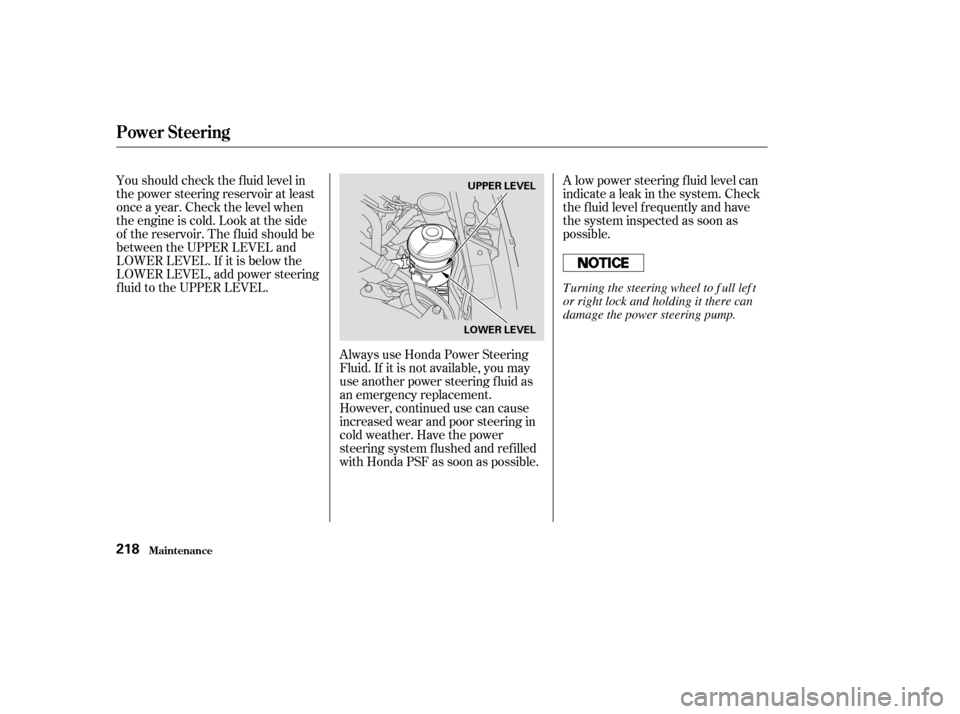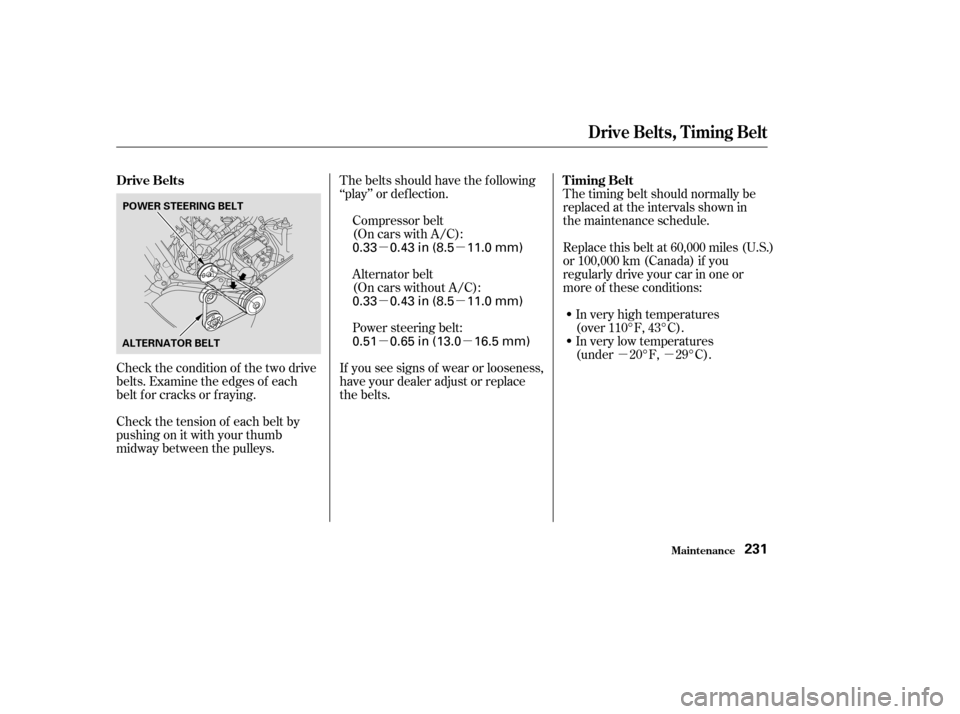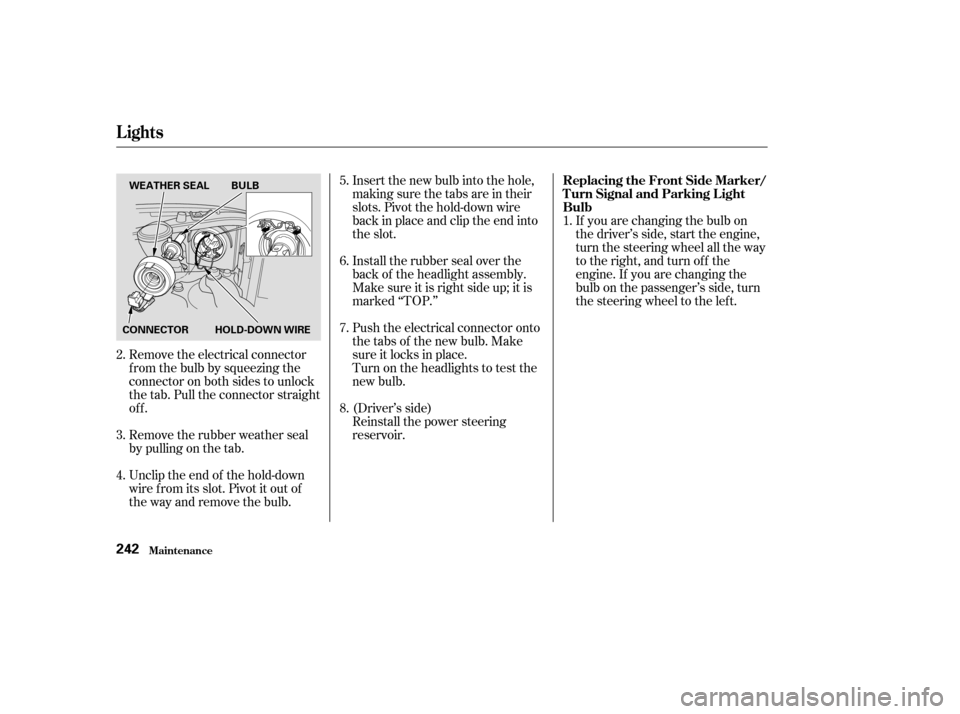Page 195 of 302
Fluid Locations
Maint enance202
ENGINE OIL
FILL CAPBRAKE FLUID
(Gray cap)
CLUTCH FLUID
(Gray cap)
WASHER FLUID
(Blue cap)
POWER STEERING
FLUID (Red cap)
AUTOMATIC
TRANSMISSION FLUID
DIPSTICK (CVT)
(Yellow loop)
RADIATOR CAP
ENGINE
COOLANT
RESERVOIR ENGINE OIL DIPSTICK
(Orange loop)
AUTOMATIC
TRANSMISSION
FLUID DIPSTICK
(Yellow loop)
�����—�����—�����y�
���������
���y���
�(���%�������y���������y
Page 211 of 302

A low power steering f luid level can
indicate a leak in the system. Check
the f luid level f requently and have
the system inspected as soon as
possible.
Always use Honda Power Steering
Fluid. If it is not available, you may
use another power steering f luid as
an emergency replacement.
However, continued use can cause
increased wear and poor steering in
cold weather. Have the power
steering system f lushed and ref illed
with Honda PSF as soon as possible.
You should check the f luid level in
the power steering reservoir at least
once a year. Check the level when
the engine is cold. Look at the side
of the reservoir. The f luid should be
between the UPPER LEVEL and
LOWER LEVEL. If it is below the
LOWER LEVEL, add power steering
f luid to the UPPER LEVEL.
Power Steering
Maint enance218
UPPER LEVEL
LOWER LEVEL
T urning the steering wheel to f ull lef t
or right lock and holding it there can
damage the power steering pump.
�����—�����—�����y�
�����������
�y���
�(���%�������y�������
�y
Page 224 of 302

�µ�µ
�µ�µ
�µ�µ �µ�µ
The belts should have the f ollowing
‘‘play’’ or def lection. The timing belt should normally be
replaced at the intervals shown in
the maintenance schedule.
In very high temperatures
(over 110°F, 43°C).
In very low temperatures
(under 20°F, 29°C).
Replace this belt at 60,000 miles (U.S.)
or 100,000 km (Canada) if you
regularly drive your car in one or
more of these conditions:
Check the condition of the two drive
belts. Examine the edges of each
belt f or cracks or f raying. Power steering belt:
Alternator belt
(On cars without A/C):
Compressor belt
(On cars with A/C):
If you see signs of wear or looseness,
have your dealer adjust or replace
the belts.
Check the tension of each belt by
pushingonitwithyourthumb
midway between the pulleys.
Drive Belts
T iming Belt
Drive Belts, T iming Belt
Maint enance231
POWER STEERING BELT
ALTERNATOR BELT
0.51 0.65 in (13.0 16.5 mm)
0.33 0.43 in (8.5 11.0 mm)
0.33 0.43 in (8.5 11.0 mm)
�����—�����—�����y�
�������������y���
�(���%�������y���������y
Page 229 of 302

The tires that came with your car
were selected to match the perform-
ance capabilities of the car while
providing the best combination of
handling, ride comf ort, and long lif e.
Youshouldreplacethemwithradial
tires of the same size, load range,
speed rating, and maximum cold tire
pressure rating (as shown on the
tire’s sidewall). Mixing radial and
bias-ply tires on your car can reduce
its braking ability, traction, and
steering accuracy. It is best to replace all f our tires atthesametime.If thatisnotpossible
or necessary, then replace the two
f ront tires or the two rear tires as a
pair. Replacing just one tire can
seriously af f ect your car’s handling.TheABSworksbycomparingthe
speed of the wheels. When replacing
tires, use the same size originally
supplied with the car. Tire size and
construction can af f ect wheel speed
and may cause the system to work
inconsistently.
If you ever need to replace a wheel,
make sure the wheel’s specif ications
match those of the original wheel
that came on your car. Replacement
wheels are available at your Honda
dealer.
Replacing T ires and Wheels
Tires
Maint enance236
Installing improper tires on your
car can affect handling and
stability. This can cause a crash
in which you can be seriously
hurt or killed.
Always use the size and type of
tires recommended in this
owner’s manual.
�����—�����—�����y�
�����������
�y���
�(���%�������y���������y
Page 234 of 302
Open the hood.
If you need to change the head-
light bulb on the driver’s side,
remove the power steering
reservoir tank by pulling it out of
its holder.
Your car has halogen headlight
bulbs, one on each side. When
replacing a bulb, handle it by its steel
base and protect the glass from
contactwithyourskinorhard
objects. If you touch the glass, clean
it with denatured alcohol and a clean
cloth.
Theheadlightswereproperlyaimed
when your car was new. If you
regularly carry heavy items in the
trunk, readjustment may be required.
Adjustment of the headlights should
be perf ormed by a Honda technician
or other qualif ied mechanic.
1.
CONT INUED
Replacing a Headlight Bulb
Headlight A iming
Lights
Maint enance241
HOLDERHalogen headlight bulbs get very hot
when lit. Oil, perspiration, or a scratch
on the glass can cause the bulb to
overheat and shatter.
�����—�����—�����y�
�������������y���
�(���%�������y���������y
Page 235 of 302

If you are changing the bulb on
the driver’s side, start the engine,
turn the steering wheel all the way
to the right, and turn off the
engine. If you are changing the
bulb on the passenger’s side, turn
the steering wheel to the left.
Reinstall the power steering
reservoir.
(Driver’s side)
Push the electrical connector onto
the tabs of the new bulb. Make
sure it locks in place.
Turn on the headlights to test the
new bulb.
Insert the new bulb into the hole,
making sure the tabs are in their
slots. Pivot the hold-down wire
back in place and clip the end into
the slot.
Install the rubber seal over the
back of the headlight assembly.
Make sure it is right side up; it is
marked ‘‘TOP.’’
Unclip the end of the hold-down
wire f rom its slot. Pivot it out of
the way and remove the bulb.
Remove the rubber weather seal
by pulling on the tab.
Remove the electrical connector
f rom the bulb by squeezing the
connector on both sides to unlock
the tab. Pull the connector straight
off.
3. 4. 5. 6. 7. 8.
1.
2. Replacing the Front Side Marker/
Turn Signal and Parking L ightBulb
Lights
Maint enance242
WEATHER SEAL BULB
CONNECTOR HOLD-DOWN WIRE
�����—�����—�����y�
�������������y���
�(���%�������y���������y
Page 269 of 302
All the electrical circuits in your car
have fuses to protect them from a
short circuit or overload. These
f uses are located in two f use boxes.The interior f use box is underneath
the steering column. To open it, turn
the knobs as shown.
The under-hood f use box is located
in the engine compartment on the
passenger’s side. To open it, push
thetabsasshown.
Fuses
T aking Care of t he Unexpect ed278
UNDER-HOOD
TAB INTERIOR
�����—�����—�����y�
���������
�
�y���
�(���%�������y�������
�y
Page 275 of 302

If you decide to tow your car with all
f our wheels on the ground, make
sure you use a properly-designed and
attached tow bar. Prepare the car for
towing as described above, and leave
the ignition switch in Accessory (I)
so the steering wheel does not lock.
Make sure the radio and any items
plugged into the accessory power
socket are turned of f so they do not
rundownthebattery.
With the f ront wheels on the ground,
it is best to tow the car no farther
than 50 miles (80 km), and keep the
speedbelow35mph(55km/h).
If your car is equipped with a f ront
spoiler, remove it bef ore towing so it
is not damaged.
Emergency T owing
T aking Care of t he Unexpect ed284
Trying to lif t or tow your car by the
bumpers will cause serious damage.
The bumpers are not designed to
support the car’s weight.
The steering system can be damaged if
the steering wheel is locked. Leave the
ignition switch in Accessory (I), and
make sure the steering wheel turns
f reely bef ore you begin towing.
�����—�����—�����y�
�������������y���
�(���%�������y���������y